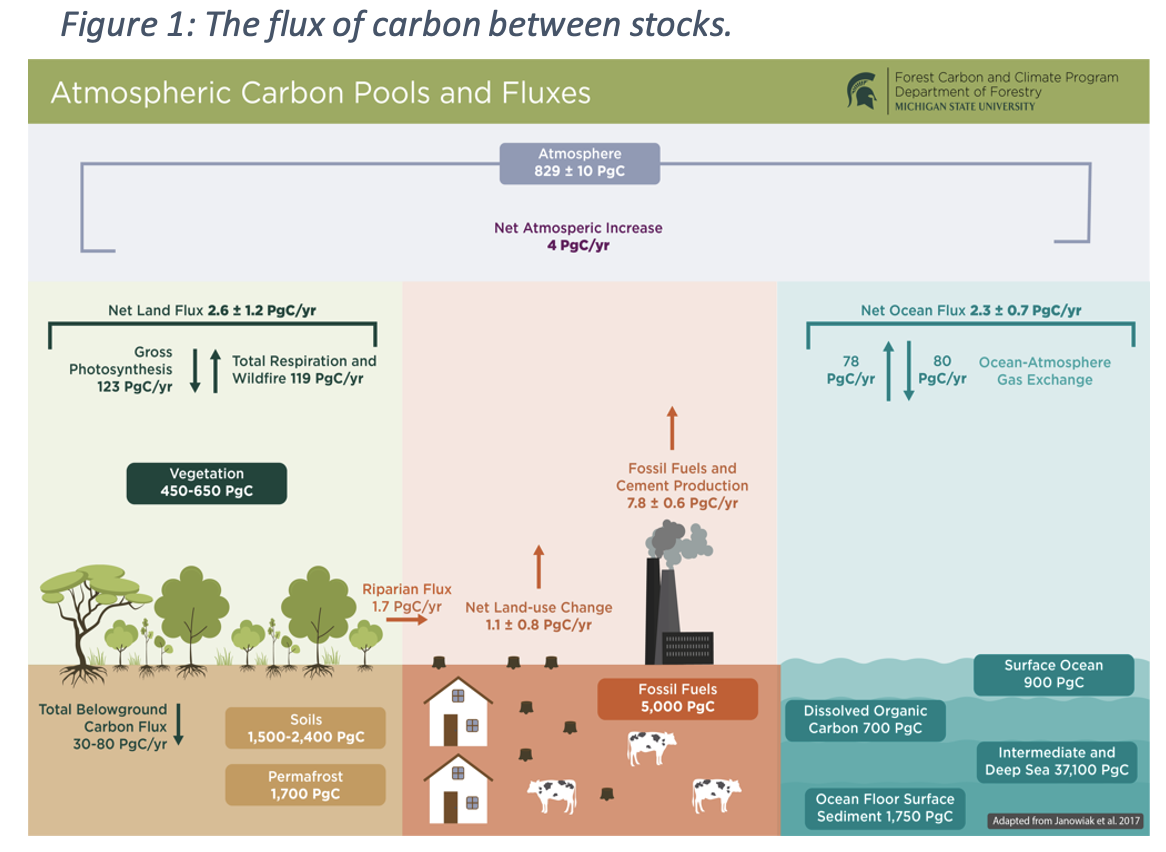Carbon Stocks, Fluxes and the Land Sector
Graham Diedrich, FCCP graduate research assistant, has written an overview discussing carbon fluxes and carbon stocks titled, "Carbon Stocks, Fluxes and the Land Sector."

Carbon Stocks, Fluxes and the Land Sector
By Graham Diedrich, Michigan State University Forest Carbon and Climate Program
Overview
A carbon stock, or carbon pool, is a system that has the capacity to store or release carbon. A carbon flux refers to the amount of carbon exchanged between carbon stocks over a specified time.1 In simple terms, it is the movement of carbon between land, oceans, atmosphere, and living things.2 This overview describes the mechanics behind carbon stocks and fluxes and highlight their impact on forest carbon.
Global Carbon Movement
Figure 1 outlines fluxes of carbon between several stocks, including the atmosphere, vegetation, belowground biomass, fossil fuels, and the ocean. In this section, we outline each element of the figure to paint a comprehensive understanding of the mechanisms involved.
The figure presented here shows global carbon stocks and fluxes. Boxes represent carbon stocks, while arrows demonstrate fluxes. The annual carbon exchange flux is represented numerically in PgC yr-1 units, in which 1 PgC is equal to 1 billion metric tons of carbon.

Oceans absorb more carbon out of the atmosphere than they release back into it each year, lending to a net ocean flux of 2.3 ± 0.7 PgC yr-1. Despite significant net carbon fluxes out of the atmosphere and into land and sea stocks, fossil fuels and net land-use change, which together release roughly 9 PgC yr-1, contribute a far greater amount of carbon into the atmosphere, thus negating any previously positive effects.
As shown in the figure, vegetation absorbs 123 PgC yr-1 and they do this through photosynthesis, where carbon is sequestered and metabolized and stored as sugars. Vegetation also releases 119 PgC yr-1 back into the atmosphere from respiration, decomposition, and other disturbance events like wildfires. As a result, the net (or total) land carbon flux results in an loss atmospheric carbon and increase in vegetative carbon at approximately 2.6 ± 1.2 PgC yr-1. Moreover, forest carbon loss can occur in response to climate-induced disturbances– including fire, pests, and invasive species– which could outweigh the greenhouse gas (GHG) mitigation benefits of existing carbon stocks.
These numbers illustrate the importance of the land sector as a centrally important carbon sink, with forests and trees being a major contributor.
The Net Land-use Change component in the central red section (1.1 PgC yr-1) reflects the stored carbon lost from deforestation and other land use changes.
Conclusion
A carbon flux represents the transfer of carbon between carbon stocks, also known as carbon pools. Fluxes occur naturally in all functioning ecosystems, including forests. However, due to disturbances related to climate change, positive carbon fluxes (net annual vegetation storage) could decrease and eventually become negative.
Over time the vegetation carbon sink could shrink or increase, demonstrating the importance of working to protect and restore global forests, as they are a key contributor to GHG mitigation efforts to combat climate change. This underscores the importance of forests and trees as key carbon stocks that must be protected.
Sources
- Melieres, M., & Marechal, C. (2015). The carbon cycle prior to the industrial era. Climate Change: Past, Present and Future. pp. 298-301.
- M.K.C. Donev et al. (2020). Energy Education - Carbon flux [Online]. Available: https://energyeducation.ca/encyclopedia/Carbon_flux#cite_ref-cc_1-0. [Accessed: January 25, 2022].
- Janowiak, M., Connelly, W.J., Dante-Wood, K., Domke, G.M., Giardina, C., Kayler, Z., Marcinkowski, K., Ontl, T., Rodriguez-Franco, C., Swanston, C., Woodall, C.W., Buford, M. (2017). Considering Forest and Grassland Carbon in Land Management. Gen. Tech. Rep. WO-95. Washington, D.C.: United States Department of Agriculture, Forest Service. 68 p.
Click here to download this piece.



 Print
Print Email
Email